|
| Anglo Saxon Chronicles - 914AD - Alfred the Great and the Burghal Hideage |
|---|
| |
|---|
| Index |
|---|
|
| Source ▲ |
|---|
The Burgal Hidage is a collection of a number of medieval texts that describe the location of defensive forts around
the state of Wessex during the time of Alfred the Great. The document was named the Burghal Hidage by F. W. Maitland in
1897 after a great deal of research into the subject.
The documents list the major defensive forts anti clockwise around Wessex starting at the unproven location of
'Eorpeburnan' somewhere on the Kent,Sussex or Surrey borders and ending at the last fort in the list at Southwark on the
Thames .
The Anglo Saxon word Burgh or more correctly Burh describes a defensive position or fort usually on a hill with a
defensive ditch and bank topped with wooden walls and an internal regular layout to help the defenders. These Burhs were
mostly built during the reign of Alfred the Great to defend Wessex against the Viking invaders.
Each Burh has a number of hides associated with it, which describes the size of the Burh and its defensive
population.
|
Size of the Forts ▲
|
|---|
The original starting text reads
To anes æcere bræde on Ɵealstillinge 7 þære Ɵære gebirirgeað. xvi hida Gif ælc hid byþ be anum men
gemannod þonne mæg man gesettan ælce gyrde mid feoƟer mannun. þonne gebyreð to
tƟentigan gyrdan on Ɵealstillinge. hundeahtatig hida.
This translates to
For one acre breadth of wall-setting & manning is required 16 hides, if each hide is one man, then the manpower to
be set for each pole is with four men. Then is required for twenty poles of wall-
setting eighty hides.
with the finishing text reading
Gif se ymbegang mara biþ. þonne mæg man eaþe þone ofereacan geþencan of þisse tale for þon ealning to
anum furlange gebyreð sixtig manna. 7. c. þonne biþ ælc gyrd mid feoƟer mannum geset
This translates to
If the surrounding is greater, then the manpower can easily be reckoned from this assessing, since there is always
required for one furlong breadth sixty men & 100; then each pole is set with four
men.
This means that from the first statement:
An acres width of wall(aprox 208ft) needs 16 hides to build - this equates to about 13ft per hide, but this appears
to be the construction dimensions.
A pole of wall(16.5 ft) requires 4 defenders and 20 poles requires 80 men, and 1 defender is required for each 4ft
of wall which is provided by 1 hide.
Therefore a hide defends 4ft of wall
From the table shown above the Hastings Burh of 500 hides would have a wall of 125 poles so about 2000ft(aprox
610mtrs) of wall which would enclose a 500ft square of land(2.3 hectares) which would have needed 500 men to defend.
|
|
wall length |
|
|
|
hides |
ft |
mtrs |
sq mtr |
hectares |
| Eorpeburnan |
324 |
1296 |
395 |
9753 |
0.98 |
| Hastings |
500 |
2000 |
610 |
23226 |
2.32 |
| Lewes |
1300 |
5200 |
1585 |
157006 |
15.70 |
| Burpham |
720 |
2880 |
878 |
48161 |
4.82 |
| Chichester |
1500 |
6000 |
1829 |
209032 |
20.90 |
| Portchester |
500 |
2000 |
610 |
23226 |
2.32 |
| Southampton |
150 |
600 |
183 |
2090 |
0.21 |
| Winchester |
2400 |
9600 |
2926 |
535122 |
53.51 |
| Wilton |
1400 |
5600 |
1707 |
182090 |
18.21 |
| Chisbury |
700 |
2800 |
853 |
45522 |
4.55 |
| Shaftesbury |
700 |
2800 |
853 |
45522 |
4.55 |
| Twynam (Christchurch) |
470 |
1880 |
573 |
20522 |
2.05 |
| Wareham |
1600 |
6400 |
1951 |
237832 |
23.78 |
| Bridport |
760 |
3040 |
927 |
53661 |
5.37 |
| Exeter |
734 |
2936 |
895 |
50052 |
5.01 |
| Halwell |
300 |
1200 |
366 |
8361 |
0.84 |
| Lydford |
140 |
560 |
171 |
1821 |
0.18 |
| Pilton |
360 |
1440 |
439 |
12040 |
1.20 |
| Watchet |
513 |
2052 |
625 |
24449 |
2.44 |
| Axbridge |
400 |
1600 |
488 |
14864 |
1.49 |
| Lyng |
100 |
400 |
122 |
929 |
0.09 |
| Langport |
600 |
2400 |
732 |
33445 |
3.34 |
| Bath |
1000 |
4000 |
1219 |
92903 |
9.29 |
| Malmesbury |
1200 |
4800 |
1463 |
133780 |
13.38 |
| Cricklade |
1500 |
6000 |
1829 |
209032 |
20.90 |
| Oxford |
1400 |
5600 |
1707 |
182090 |
18.21 |
| Wallingford |
2400 |
9600 |
2926 |
535122 |
53.51 |
| Buckingham |
1600 |
6400 |
1951 |
237832 |
23.78 |
| Sashes |
1000 |
4000 |
1219 |
92903 |
9.29 |
| Eashing |
600 |
2400 |
732 |
33445 |
3.34 |
| Southwark |
1800 |
7200 |
2195 |
301006 |
30.10 |
| Worcester |
1200 |
4800 |
1463 |
133780 |
13.38 |
| Warwick |
2400 |
9600 |
2926 |
535122 |
53.51 |
|
| |
|---|
| Likely Locations of the Burh's ▲ |
|---|
The images below are made up from, to the left, based on Google My Maps overlayed with the fort area, those to the right
are from the National Library of Scotland with the 'OS Six inch map 1888-1915' overlayed with a 'Lidar DSM 1M' lidar
image.
|
| |
|---|
| Eorpeburnan -324 hides ▲ |
|---|
| Eorpburnan actually spelt eorþ burnan means the earthy
stream |
| Most likely location is modern Orpington which translates from eorþ ing tun
meaning the earth fort on the hill |
|
|
Hastings | | 500 hides |
|---|
| The fort was probably at Baldslow down which derives from baels hleow
dun meaning the fire refuge on the hill |
|
|
|
Lewes | | 1300 hides |
|---|
|
|
|---|
| probably located on offham hill - Lewes derives from hleow
aes which translates to the refuge by the river |
|
|
|
Burpham | | 720 hides |
|---|
|
|
|---|
| Burpham from burþ ham which translates to the fortress settlement in the
valley |
|
|
| |
|---|
Chichester - 1500 hides ▲
|
|---|
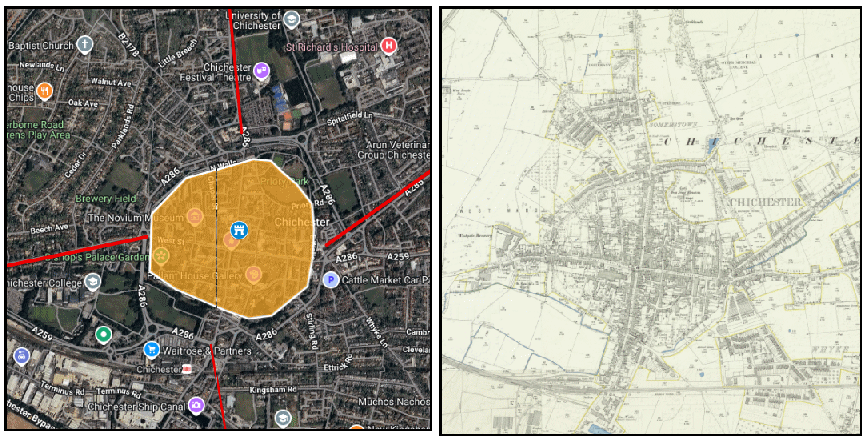
| Chichester derives from chyee ceaster which translates to the roman fortress
of the Crows |
| The area covered by the image is the boundary of the old Roman fortress which has a boundary of 2140m
and an area of 34.4 hectares. |
|
| |
|---|
Portchester - 500 hides ▲
|
|---|
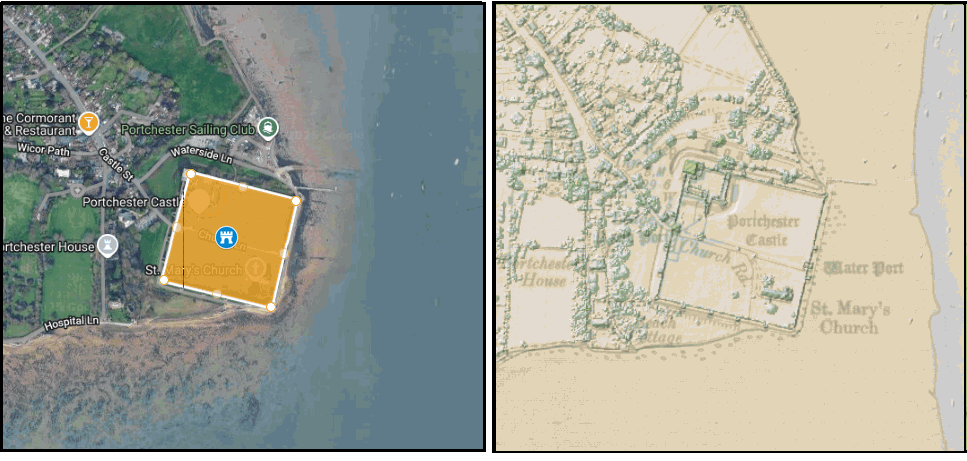
| Portchester derives from port ceaster which translates to the roman fortress
with the harbour. The area covered by the image has a boundary of 740m and an area of 3.42
hectares. |
|
| |
|---|
Southampton - 150 hides ▲
|
|---|
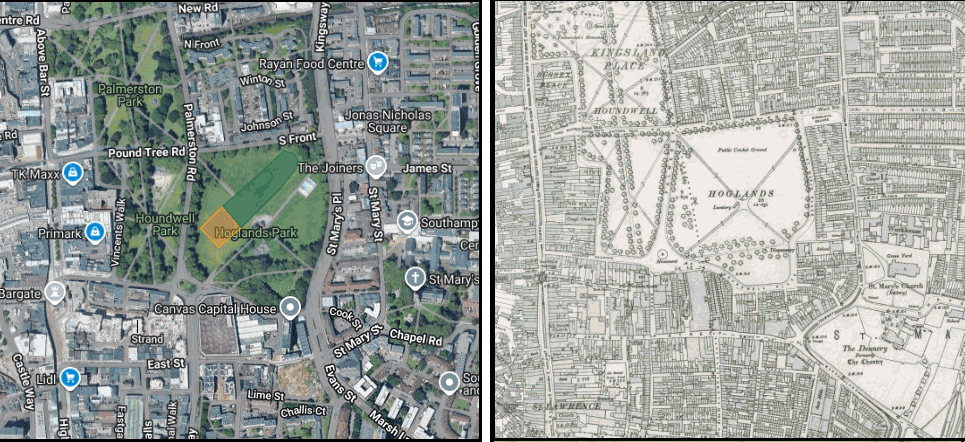
| Southampton derives from suþ þam tun which translates to the southern wet
place on the hill |
| Please Note: It is difficult to identify a site in Southampton due to the sheer
number of buildings that have been erected since 914AD. However I have noticed that the Burhs are sometimes on playing
fields, and this one is called Hoglands that may have been derived from 'Hleow land' meaning the land where the burh is,
so that is my Guess. There seem to be ground marks on the Google maps where the orange patch is located..
The area covered by the orange image has a boundary of 198m and an area of 0.24 hectares. |
|
| |
|---|
Winchester - 2400 hides ▲
|
|---|
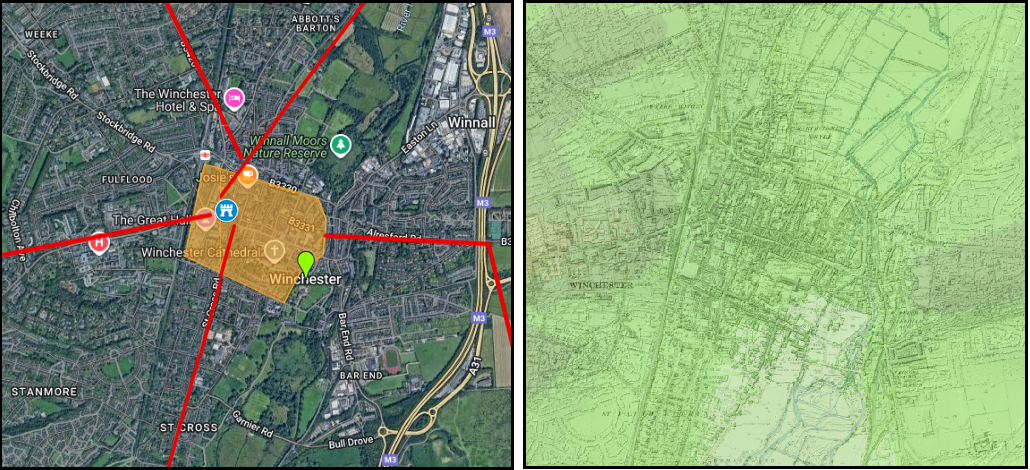
| Winchester derives from win ceaster which translates to the roman fortress of
the wine |
| The area covered by the image is the boundary of the old Roman fortress which has a boundary of 3000m
and an area of 58.6 hectares. |
|
| |
|---|
Wilton - 1400 hides ▲
|
|---|
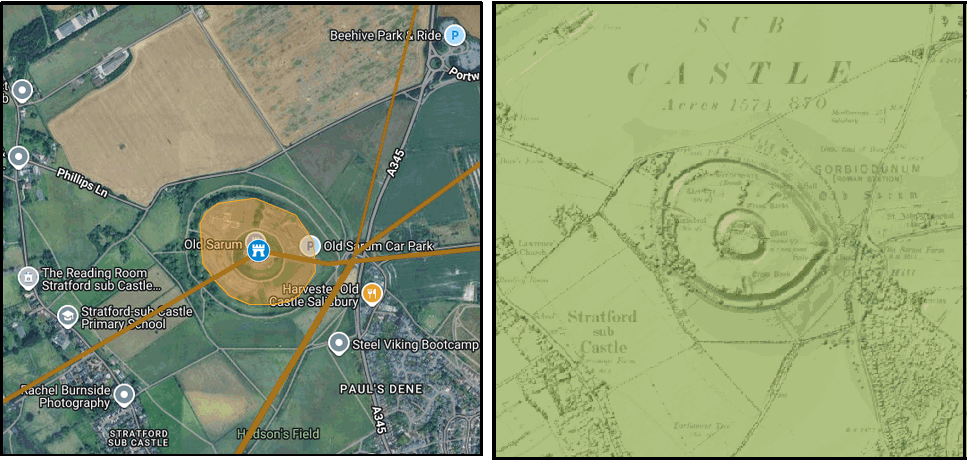
| The most likely location for this fort was at Old Sarum the old Roman fort on the
junction of two major Roman roads. The area covered by the image has a boundary of 1.4km and an area of 15.0
hectares |
|
| |
|---|
Chisbury - 700 hides ▲
|
|---|
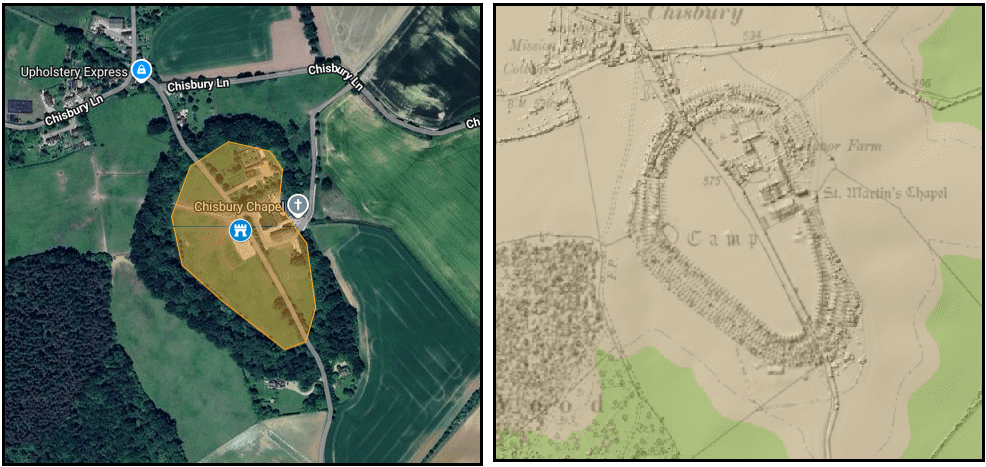
| Chisbury derived from 'cise byrg' - the cheese fort |
|---|
| The most likely location for this fort was at Chisbury Camp an old Iron Age
fort.The area covered by the image has a boundary of 866m and an area of 4.92 hectares. |
|
|
Shaftesbury | | 700 hides |
|---|
| The most likely location for this fort was at Shaftesbury Castle an old Iron Age
fort |
|
|
|
Twynam (now called Christchurch, Dorset) | | 470 hides |
|---|
| The most likely location for this fort was on 'St Catherines Hill' an old Roman
signalling station |
|
|
|
Wareham | | 1600 hides |
|---|
| The most likely location for this fort was in Wareham itself, wær ham meaning
sea valley settlement |
|
|
| |
|---|
Bridport - 760 hides ▲
|
|---|
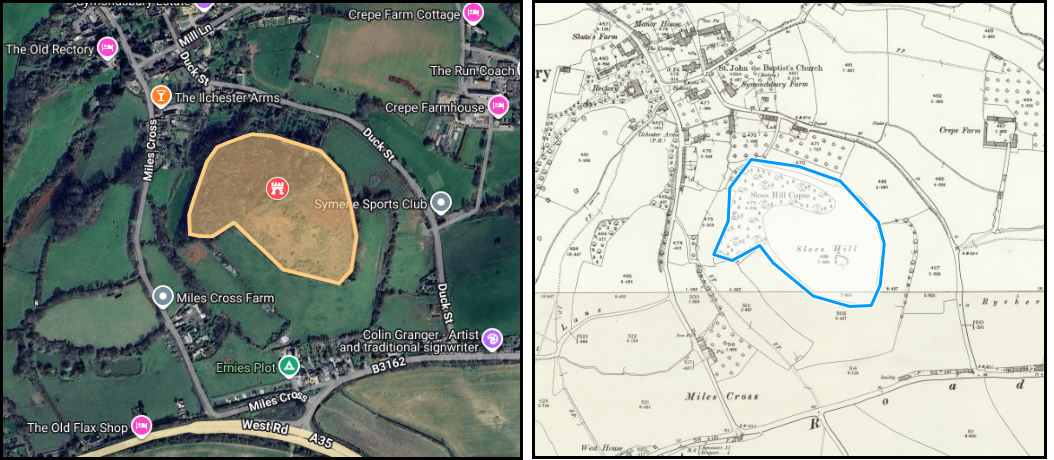
| probably located on Sloes Hill which is likely to be derived from eas
hloes hyll which translates to the riverside refuge on the hill |
|
|
Exeter | | 734 hides |
|---|
| The most likely location for this fort was the Roman fort in Exeter(Isca) |
|
|
| |
|---|
Halwell - 300 hides ▲
|
|---|
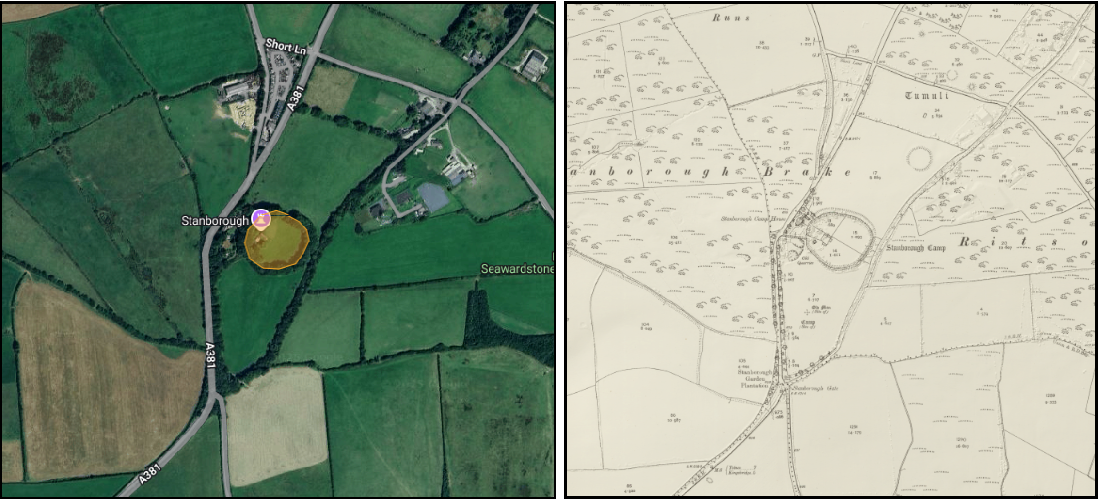
| The most likely location for this fort was the hill fort at Stanborough Camp, stane borough means the stone fortress, or the fortress on the roman road. The area
covered by the image has a boundary of 345m and an area of 0.91 hectares. |
|
| |
|---|
Lydford - 140 hides ▲
|
|---|

| The most likely location for this fort at Lydford is on ths small hill near to Eastern
Cleve wood, on modern maps is marked as Lydford Norman ringwork. The area covered by the orange area has a boundary of
190m and an area of 0.27 hectares. |
|
|
Pilton | | 360 hides |
|---|
| The most likely location was an old iron age fort called RoboroughCamp who's name could have derived from the Saxon hleow
borough meaning the old roman fort refuge |
|
|
|
Watchet | | 513 hides |
|---|
| The most likely location was an old iron age fort called Dawes
Castle |
|
|
|
Axbridge | | 400 hides |
|---|
| The fort was probably on 'Callow Hill' which derives from Cal hleow
Hyll meaning cabbage refuge hill |
|
|
| |
|---|
Lyng - 100 hides ▲
|
|---|
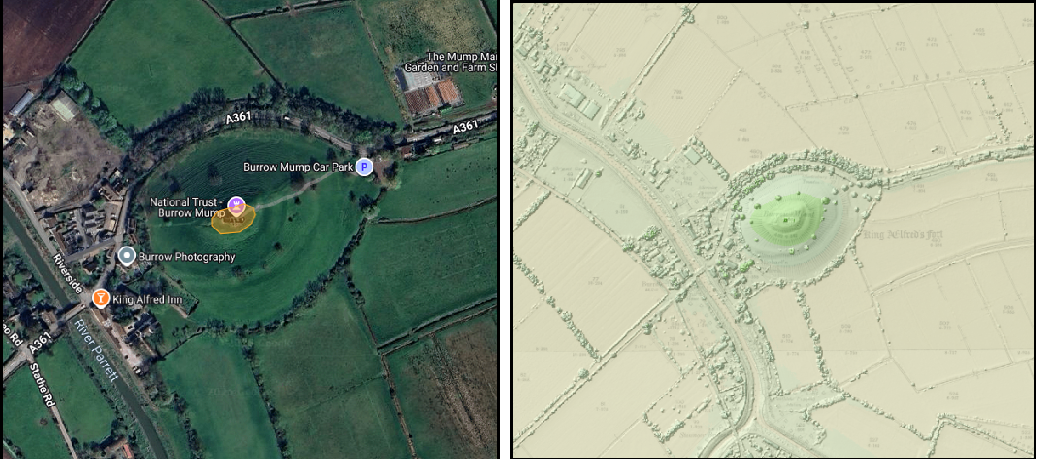
| This location must be near Athelney where Alfred the Great fled in 878AD this small fort
is most likely located on Burrow mump - which was Burh hleow munt - meaning the fort
refuge on the mound. The area covered by the image has a boundary of 117m and an area of 0.94 hectares |
|
| |
|---|
| Langport - 600 hides ▲ |
|---|
| Meaning the long port as the sea reached here in the times of Wessex. The fort was most
likely to be found in the location of Combe quarry but any evidence would be long since removed. |
|
|
Bath | | 1000 hides |
|---|
| The location for the Burh is in the old Roman center of the town. |
|
|
|
Malmesbury | | 1200 hides |
|---|
| Probably on the Holloway road translated from hoh hleow ǽ
which means the promontory refuge on the river |
|
|
|
Cricklade | | 1500 hides |
|---|
| The fort was most likely in Cricklade - the name derives from crycc gelad which
means the strong stick road, which refers to the well built straight Roman Ermin Street from Speen to Cirencester
that crosses the Thames at this point. |
|
|
|
|
|
Wallingford | | 2400 hides |
|---|
| The fort was most likely in the town where the current town walls are. |
|
|
|
|
|
|
| |
|---|
Eashing - 600 hides ▲
|
|---|
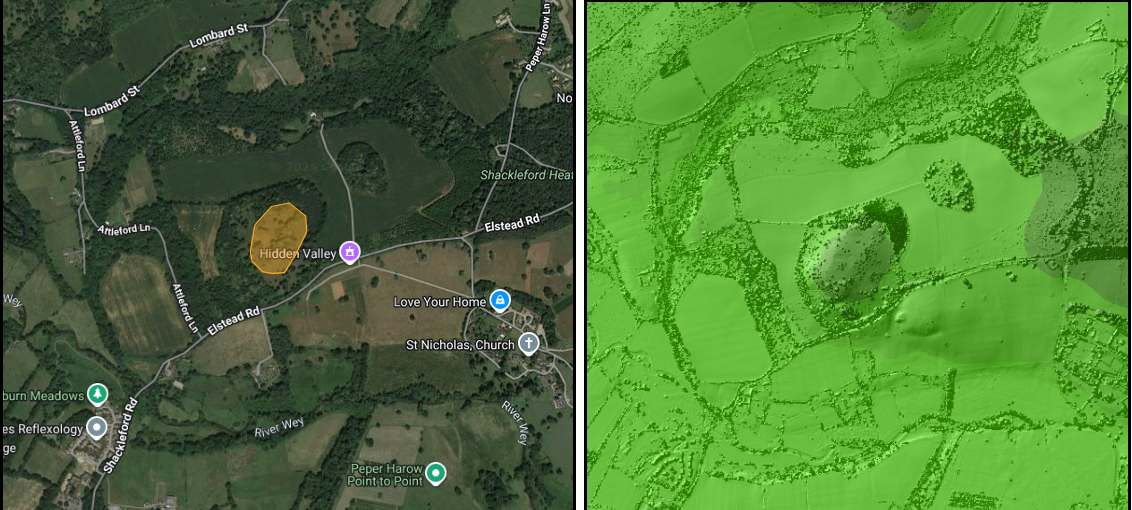
|
| | |
|---|
| The fort was most likely at Peper Harow as this derives from piþa
hár hleów meaning the old pith refuge . The likely location is on Warren Hill just above the river
Wey. The area covered by the image has a boundary of 690m and an area of 3.93 hectares. |
|
|
|
Southwark | | 1800 hides |
|---|
| The fort was probably somewhere near Crystal Palace or the high ground near Forest Hill,
but modern buildings would have removed any evidence |
|
|
|
Worcester | | 1200 hides |
|---|
| The fort was most likely near Hallow park which derives from har
hleów meaning the the old refuge |
|
|
|
Warwick | | 2400 hides |
|---|
| The fort was most likely near Woodloes farm which derives from wudu
hleów es meaning the the people of the wood refuge |
|